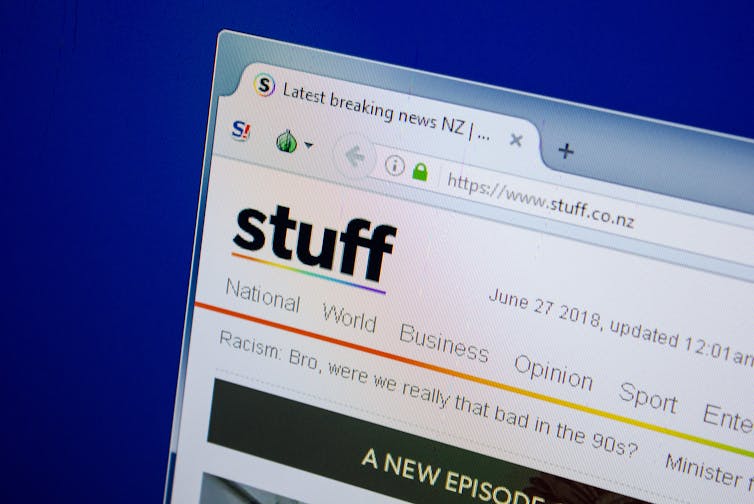Merja Myllylahti, Auckland University of Technology
When Bauer Media announced the closure of its New Zealand magazine operation just a week into level 4 lockdown in early April, things looked ominous for local media. Revenues and newsrooms were already contracting. It was hard to see things improving.

However, while the full picture is still unclear, it seems most of New Zealand’s TV, radio and print outlets have come through the COVID-19 crisis bruised and battered — but alive. Sadly, an estimated 637 media jobs have disappeared in the process.
In short, 2020 has left the New Zealand media market profoundly restructured.
Perhaps most significantly, as the tenth New Zealand Media Ownership Report shows, there are now more independent news outlets in the market than at any time in the past decade.
That trend was underscored by Australian Nine Entertainment selling (for NZ$1) its New Zealand subsidiary Stuff to CEO Sinead Boucher. The sale returned the country’s largest digital news platform and 12 national and regional newspapers to local ownership.
The magazine massacre
Many of these structural changes in the country’s media might have happened anyway, but the pandemic certainly accelerated some decisions.
A case in point was Bauer. The company blamed its closure on “the severe economic impact of COVID-19”, but it had been facing declining advertising revenue well before the pandemic hit. This was made worse when magazines were not included among essential goods and services during the lockdown in March and April.
Bauer also closed titles in Australia, but in June the company’s Australasian magazines were sold to Australian private equity group Mercury Capital. The new owner resumed publication of Woman’s Day, New Zealand Woman’s Weekly, Australian Women’s Weekly NZ, Your Home & Garden, NZ Listener and Kia Ora.
Later, flagship current affairs titles North & South and Metro were sold to independent publishers and relaunched in November.
A government lifeline
You might say the country’s media survived the pandemic with a little help from friends — and even frenemies: the government, readers and Google.
In April, the government announced a $50 million media crisis support package — the lion’s share went to broadcasting.
But most of the country’s news outlets received support from the government’s wage subsidy scheme, including NZ Media and Entertainment (NZME) and Stuff, the two largest print and online news publishers.
Without that government support it’s clear many news outlets would have been more severely affected. The NZ Herald received $8.6 million in wage subsidy and Stuff $6.2 million. State-owned broadcaster TVNZ received $5.9 million and the private-equity-owned MediaWorks $3.6 million.
The scheme also kept many smaller digital news outlets afloat, and some even expanded.
The Google factor
Some news outlets received additional funding from Google’s Journalism Emergency Relief Fund — slightly ironic, given the impact of the digital giant on traditional media advertising revenues (hence the “frenemy” tag).
A total of 76 news organisations across the Pacific benefited from Google’s “short-term relief”. While smaller publishers welcomed it, the money spent per outlet was unlikely to make any serious dent in Google’s budget — it was more a gesture of goodwill.
For example, Queenstown-based non-profit media outlet Crux received $5,000. To put that in context, in the first half of 2020 search engines — mainly Google — received $361 million in digital advertising revenue in New Zealand, along with the social media platforms gobbling up 72% of the country’s total digital advertising spend.
For its part, Google says it has done more for the country’s journalism than providing financial aid, and has “trained almost 600 journalists in dozens of newsrooms across the country”.
Higher traffic and increased donations
News companies also got by with a little help from their readers during the pandemic. The NZ Herald reported “overall print-digital readership […] at record levels and newspaper readership [at] its highest in almost a decade”.
Independent digital news outlets Newsroom and The Spinoff also reported spikes in readership and donations or subscriptions. Web analytics confirm overall news site traffic increased quite substantially during the pandemic.
According to data analysts SimilarWeb, total visits to the NZ Herald website grew from 36.5 million in May to 46.4 million in August. Similarly, total visits to the Stuff site went from 39.7 million in May to 43 million in August, while The Spinoff grew from 2.4 million in May to 2.9 million in July.
These positive developments were offset by plenty of negatives, however. Many commercial newsrooms shrank substantially, with hundreds of jobs lost. The full effects of the pandemic will not be known for some time, and what the industry will look like in 12 months is hard to predict.
What is clear, though, is that more government support will be needed in the coming years if New Zealand wants a healthy media system as part of its democracy.
Merja Myllylahti, Co-Director, JMAD Research Centre, Auckland University of Technology
This article is republished from The Conversation under a Creative Commons license. Read the original article.












